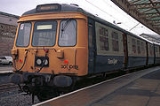
List of British Rail electric multiple unit classes
Encyclopedia
This page lists every electric
-powered multiple unit allocated a TOPS
classification or used on the mainline network since 1948 (i.e. British Rail
ways and post-privatisation). For a historical overview of multiple unit
development in Great Britain, see British diesel and electric multiple units
.
British Rail operated a wide variety of electric multiple unit
s for use on electrified lines
:
.jpg)


 These use electrical switching devices (thyristor
These use electrical switching devices (thyristor
s and transistor
s) and have electronic power control.

and its successor, the Southern Region of British Rail, used three letter codes
to classify their DC EMU fleets, as shown after the TOPS
class numbers. Southern Region EMUs were classified in the 400 series under TOPS.
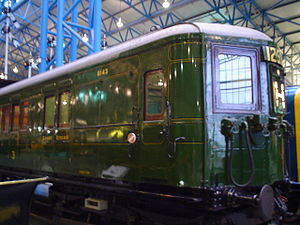
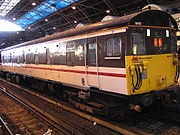

Tube


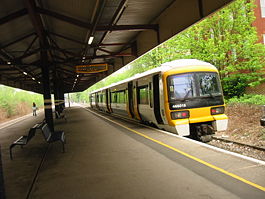
, Manchester
and Merseyside
and the OHLE lines in Greater Manchester
. The DC electric network around Tyneside
had been de-electrified by the time TOPS
was introduced, and the stock withdrawn or transferred to the Southern Region.
 TOPS classes
TOPS classes
Pre-TOPS classes
.
and Tyne & Wear Metro
trains have their own TOPS classes:
Electric locomotive
An electric locomotive is a locomotive powered by electricity from overhead lines, a third rail or an on-board energy storage device...
-powered multiple unit allocated a TOPS
TOPS
Total Operations Processing System, or TOPS, is a computer system for managing the locomotives and rolling stock owned by a rail system...
classification or used on the mainline network since 1948 (i.e. British Rail
British Rail
British Railways , which from 1965 traded as British Rail, was the operator of most of the rail transport in Great Britain between 1948 and 1997. It was formed from the nationalisation of the "Big Four" British railway companies and lasted until the gradual privatisation of British Rail, in stages...
ways and post-privatisation). For a historical overview of multiple unit
Multiple unit
The term multiple unit or MU is used to describe a self-propelled carriages capable of coupling with other units of the same or similar type and still being controlled from one driving cab. The term is commonly used to denote passenger trainsets consisting of more than one carriage...
development in Great Britain, see British diesel and electric multiple units
British diesel and electric multiple units
'Multiple Unit' is a term used to describe a train which does not have a separate locomotive. Typically these are passenger trains with accommodation in every vehicle and motors or engines distributed under the floor along the length of the train...
.
British Rail operated a wide variety of electric multiple unit
Electric multiple unit
An electric multiple unit or EMU is a multiple unit train consisting of self-propelled carriages, using electricity as the motive power. An EMU requires no separate locomotive, as electric traction motors are incorporated within one or a number of the carriages...
s for use on electrified lines
Railway electrification in Great Britain
Railway electrification in Great Britain started towards of the 19th century. A great range of voltages have been used in the intervening period using both overhead lines and third rails, however the most common standard for mainline services is now 25 kV AC using overhead lines and the...
:
- AC units operate off 25 kVVoltThe volt is the SI derived unit for electric potential, electric potential difference, and electromotive force. The volt is named in honor of the Italian physicist Alessandro Volta , who invented the voltaic pile, possibly the first chemical battery.- Definition :A single volt is defined as the...
alternating currentAlternating currentIn alternating current the movement of electric charge periodically reverses direction. In direct current , the flow of electric charge is only in one direction....
(AC) from overhead wires. Where clearances for the overhead wires on the Great Eastern Main LineGreat Eastern Main LineThe Great Eastern Main Line is a 212 Kilometre major railway line of the British railway system, which connects Liverpool Street in the City of London with destinations in east London and the East of England, including Chelmsford, Colchester, Ipswich, Norwich and several coastal resorts such as...
and London, Tilbury and Southend railwayLondon, Tilbury and Southend RailwayThe London, Tilbury and Southend Railway is an English railway line linking Fenchurch Street railway station in the City of London with northeast London and the entire length of the northern Thames Gateway area of southern Essex. It is currently known as the Essex Thameside Route by Network Rail...
routes were below standard, a reduced voltage of 6.25 kV AC was used. The Midland Railway units used 6.6 kV AC. Under the computer numbering, AC units (including mixed-voltage units that can also work off a DC supply) were given a class in the range 300-399.
- DC units operate off 650-850 VVoltThe volt is the SI derived unit for electric potential, electric potential difference, and electromotive force. The volt is named in honor of the Italian physicist Alessandro Volta , who invented the voltaic pile, possibly the first chemical battery.- Definition :A single volt is defined as the...
direct currentDirect currentDirect current is the unidirectional flow of electric charge. Direct current is produced by such sources as batteries, thermocouples, solar cells, and commutator-type electric machines of the dynamo type. Direct current may flow in a conductor such as a wire, but can also flow through...
(DC) from a third rail on the Southern RegionSouthern Region of British RailwaysThe Southern Region was a region of British Railways from 1948. The region ceased to be an operating unit in its own right in the 1980s and was wound up at the end of 1992. The region covered south London, southern England and the south coast, including the busy commuter belt areas of Kent, Sussex...
and North London, Merseyside and Tyneside networks. The Manchester-Bury Railway line used 1,200 V DC from a side-contact third rail. The Manchester South Junction & Altrincham and "Woodhead" and initially the Great Eastern RailwayGreat Eastern RailwayThe Great Eastern Railway was a pre-grouping British railway company, whose main line linked London Liverpool Street to Norwich and which had other lines through East Anglia...
routes used 1,500 V DC from overhead wires. Under the computer numbering, DC units were given a class in the range 400-599.
First generation
.jpg)

| TOPS class | Pre-TOPS class | Name or Information | Image |
|---|---|---|---|
| Ex-MR units MR electric units The Midland Railway experimented with electrification on its Heysham–Morecambe–Lancaster line in Lancashire, England. Electric trains started to run over this route in 1908, using the overhead 6.6 kV, 25 Hz AC electric supply installed and generated at the MR's own power station in Heysham.The... |
Lancaster-Morecambe-Heysham | ||
| Class 300 British Rail Class 300 Class 300 was allocated to a proposed fleet of parcels-carrying electric multiple units, which were to be converted from former Class 307 units.In the early 1990s, the Class 307 passenger units were being withdrawn from service... |
Proposed parcels units | ||
| AM1 British Rail Class AM1 Class AM1 was allocated to the prototype AC electric multiple units, converted from fourth-rail DC electric stock in 1952 and used on the Lancaster/Morecambe/Heysham route... |
25 kV AC prototype units | ||
| Class 302 British Rail Class 302 The British Rail Class 302 was a type of electric multiple unit introduced between 1958 - 1960 for outer suburban passenger services on the London, Tilbury and Southend Railway route... |
AM2 | London-Tilbury-Southend | _298_1964_barking.jpg) |
| Class 303 British Rail Class 303 The British Rail Class 303 electric multiple units, also known as "Blue Train" units, were introduced in 1960 for the electrification of the North Clyde and the Cathcart Circle lines in Strathclyde... |
AM3 | Strathclyde. Also on Greater Manchester area services during 1980s/early 1990s. | |
| Class 304 British Rail Class 304 The British Rail Class 304 electric multiple units were built for suburban use on the first phases of the West Coast Main Line electrification between Crewe and Manchester/Liverpool/Rugby. Originally classed as AM4 units, they later became Class 304 under the TOPS numbering system, and could be... |
AM4 | Greater Manchester, Liverpool, Birmingham | |
| Class 305 British Rail Class 305 The British Rail Class 305 was an alternating current electric multiple unit . Under the pre-1973 British Rail numbering system, the class was known as AM5... |
AM5 | Chingford, Enfield | 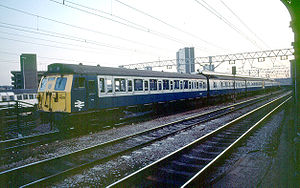 |
| Class 306 British Rail Class 306 The British Rail Class 306 was a type of electric multiple unit introduced in 1949. It consisted of 92 three-car trains which were used on newly electrified suburban lines between and London Liverpool Street.- Overview :... |
AM6 | Shenfield (inner-suburban) |  |
| Class 307 British Rail Class 307 The British Rail Class 307 electric multiple units were built by BR at Eastleigh Works from 1954-1956. They were initially classified as AM7 before the introduction of TOPS.-Description:... |
AM7 | Southend (outer-suburban) |  |
| Class 308 British Rail Class 308 The British Rail Class 308 alternating current electric multiple units were built by BR at York, in three batches, from 1959–61. They were initially classified as AM8 units before the introduction of TOPS.-Class 308/1:... |
AM8 | Eastern Region lines |  |
| Class 309 British Rail Class 309 The British Rail Class 309 "Clacton Express" electric multiple units were built by British Rail York Works from 1962-1963. They were initially classified as Class AM9 before the introduction of TOPS... |
AM9 | Clacton Express. |  |
| Class 310 British Rail Class 310 The British Rail Class 310 is a slam-door, alternating current electric multiple unit introduced in 1963 as part of the West Coast Main Line electrification project. They were initially classified as Class AM10 units before the introduction of the TOPS classification system. Constructed at BR's... |
AM10 | Euston outer-suburban. Also West Midlands |  |
| Class 311 British Rail Class 311 The British Rail Class 311 alternating current electric multiple units were built by Cravens at Sheffield in 1967. They were intended for use on the line from to and , which was electrified in 1967.-Appearance:... |
AM11 | Strathclyde | 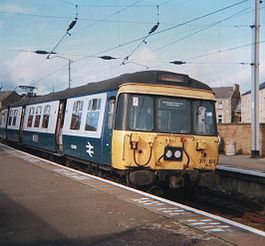 |
| Class 312 British Rail Class 312 The British Rail Class 312 is a type of alternating current electric multiple unit built in 1975-1978 for use on outer-suburban passenger services. It was the last class of multiple unit to be constructed with the British Rail Mark 2 bodyshell, and also the last with slam doors... |
Great Eastern suburban Great Northern suburban West Midlands (four units) |
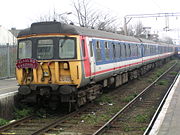 |
Second generation

| TOPS class | Built for | Current Operator(s) | Builder | Number built | Image |
|---|---|---|---|---|---|
| Class 313 British Rail Class 313 British Rail Class 313 electric multiple units were built by BREL at York Works between February 1976 and April 1977 and were the first second-generation EMUs to be constructed for British Rail... |
BR Eastern Region Eastern Region of British Railways The Eastern Region was a region of British Railways from 1948. The region ceased to be an operating unit in its own right in the 1980s and was wound up at the end of 1992... (Great Northern suburban) |
Southern Southern (train operating company) Southern is a train operating company in the United Kingdom. Officially named Southern Railway Ltd., it is a subsidiary of Govia, a joint venture between transport groups Go-Ahead Group and Keolis, and has operated the South Central rail franchise since October 2000 and the Gatwick Express service... , First Capital Connect First Capital Connect First Capital Connect is a passenger train operating company in England that began operations on the National Rail network on 1 April 2006... |
BREL York 1976-77 | 64 x 3-car sets | 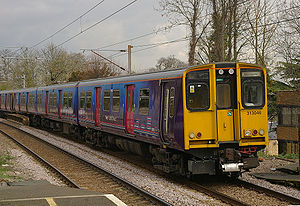 |
| Class 314 British Rail Class 314 British Rail Class 314 alternating current electric multiple units were built by BREL at York works in 1979. They were the third variety of British Rail's then-standard 1972 design for suburban EMUs, which eventually encompassed 755 vehicles and five classes... |
BR Scottish Region Scottish Region of British Railways The Scottish Region was one of the six regions created on British Railways and consisted of ex-London, Midland and Scottish Railway and ex-London and North Eastern Railway lines in Scotland... (Argyle Line Argyle Line The Argyle Line is a suburban railway located in West Central Scotland. It connects the Lanarkshire towns of Lanark, Larkhall and Motherwell to West Dunbartonshire via central Glasgow using sub-surface running... ) |
First ScotRail First ScotRail ScotRail Railways Ltd. is the FirstGroup-owned train operating company running domestic passenger trains within Scotland, northern England and the cross-border Caledonian Sleeper service to London using the brand ScotRail which is the property of the Scottish Government... |
BREL York 1979 | 16 x 3-car sets | 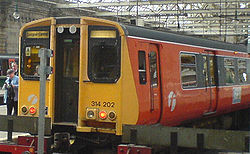 |
| Class 315 British Rail Class 315 British Rail Class 315 alternating current electric multiple units were built by BREL at York works from 1980 to 1981. They were the fifth and final variety of British Rail's then-standard 1972 design for suburban EMUs, which eventually encompassed 755 vehicles and five Classes... |
BR Eastern Region Eastern Region of British Railways The Eastern Region was a region of British Railways from 1948. The region ceased to be an operating unit in its own right in the 1980s and was wound up at the end of 1992... (Great Eastern suburban) |
National Express East Anglia | BREL York 1980-81 | 61 x 4-car sets |  |
| Class 316 (I) | (AC Networker prototype) | (never used in passenger service, now out of service) | converted from class 210 and 313 cars | 1 x 4-car set |  |
| Class 316 (II) British Rail Class 307 The British Rail Class 307 electric multiple units were built by BR at Eastleigh Works from 1954-1956. They were initially classified as AM7 before the introduction of TOPS.-Description:... |
(test unit) | (never used in passenger service, now out of service) | converted from class 307 | 1 x 3-car set | |
| Class 317 British Rail Class 317 The British Rail Class 317 alternating current electric multiple units were built by BREL York in two batches, from 1981-82 and 1985-87. They were the first of several classes of British Rail EMU to be based on the all-steel Mark 3 bodyshell, departing from the "PEP"-aluminium design which had... |
Class 317/1 London Midland Region Class 317/2 Network SouthEast Network SouthEast Network SouthEast was one of three passenger sectors of British Rail created in 1982. NSE principally operated commuter trains in the London area and inter-urban services in densely populated South East England, although the network reached as far west as Exeter... ('Bedpan' and Great Northern lines) |
National Express East Anglia, First Capital Connect First Capital Connect First Capital Connect is a passenger train operating company in England that began operations on the National Rail network on 1 April 2006... |
BREL York 1981-82(317/1) 1985-87(317/2) |
72 x 4-car sets |  |
| Class 318 British Rail Class 318 The British Rail Class 318 is an electric multiple unit train, which operates exclusively in the Strathclyde Partnership for Transport network in West Central Scotland. The units were introduced fully on 29 September 1986 as part of the electrification of the Ayrshire Coast Line between and... |
Provincial ScotRail Regional Railways Regional Railways was one of the three passenger sectors of British Rail created in 1982 that existed until 1996, 3 years after privatisation. The sector was originally called Provincial.... (for Strathclyde PTE) |
First ScotRail First ScotRail ScotRail Railways Ltd. is the FirstGroup-owned train operating company running domestic passenger trains within Scotland, northern England and the cross-border Caledonian Sleeper service to London using the brand ScotRail which is the property of the Scottish Government... |
BREL York 1984-86 | 21 x 3-car sets |  |
| Class 319 British Rail Class 319 The British Rail Class 319 dual-voltage electric multiple units were built by BREL York in two batches in 1987–88 and 1990. The trains were introduced for new north-south cross-London services from Bedford to Brighton, and since privatisation these services have been operated by Thameslink and... |
Network SouthEast Network SouthEast Network SouthEast was one of three passenger sectors of British Rail created in 1982. NSE principally operated commuter trains in the London area and inter-urban services in densely populated South East England, although the network reached as far west as Exeter... (Thameslink Thameslink Thameslink is a fifty-station main-line route in the British railway system running north to south through London from Bedford to Brighton, serving both London Gatwick Airport and London Luton Airport. It opened as a through service in 1988 and by 1998 was severely overcrowded, carrying more than... services) |
First Capital Connect First Capital Connect First Capital Connect is a passenger train operating company in England that began operations on the National Rail network on 1 April 2006... |
BREL York 1987-88(319/0) 1990(319/1) |
86 x 4-car sets |  |
| Class 320 British Rail Class 320 The British Rail Class 320 is an alternating current electric multiple unit train found on the Strathclyde Partnership for Transport rail network in Central Scotland, and is used exclusively on the North Clyde Line between Helensburgh and Airdrie, North Lanarkshire via Glasgow Queen Street... |
Provincial ScotRail Regional Railways Regional Railways was one of the three passenger sectors of British Rail created in 1982 that existed until 1996, 3 years after privatisation. The sector was originally called Provincial.... (for Strathclyde PTE) |
First ScotRail First ScotRail ScotRail Railways Ltd. is the FirstGroup-owned train operating company running domestic passenger trains within Scotland, northern England and the cross-border Caledonian Sleeper service to London using the brand ScotRail which is the property of the Scottish Government... |
BREL York 1990 | 22 x 3-car sets | |
| Class 321 British Rail Class 321 The British Rail Class 321 alternating current electric multiple units were built by BREL York in three batches from 1988-91. The design was successful and led to the development of the similar Class 320 and Class 322 units for use by Strathclyde PTE and Stansted Express respectively... |
Network SouthEast Network SouthEast Network SouthEast was one of three passenger sectors of British Rail created in 1982. NSE principally operated commuter trains in the London area and inter-urban services in densely populated South East England, although the network reached as far west as Exeter... (Great Eastern and Euston services); and Regional Railways Regional Railways Regional Railways was one of the three passenger sectors of British Rail created in 1982 that existed until 1996, 3 years after privatisation. The sector was originally called Provincial.... (for West Yorkshire PTE) |
National Express East Anglia, Northern Rail Northern Rail Northern Rail is a British train operating company that has operated local passenger services in Northern England since 2004. Northern Rail's owner, Serco-Abellio, is a consortium formed of Abellio and Serco, an international operator of public transport systems... , London Midland London Midland London Midland is a train operating company in the United Kingdom. Legally named London and Birmingham Railway Ltd, it is a subsidiary of Govia, and has operated the West Midlands franchise since 11 November 2007.... , First Capital Connect First Capital Connect First Capital Connect is a passenger train operating company in England that began operations on the National Rail network on 1 April 2006... |
BREL York 1988-1991 | 117 x 4-car sets | |
| Class 322 British Rail Class 322 The British Rail Class 322 electric multiple units were built by BREL in 1990. Five 4-car units were built for the dedicated Stansted Express service from London Liverpool Street to Stansted Airport. The units were then used by First ScotRail, operating on the North Berwick Branch Line, between /... |
Network SouthEast Network SouthEast Network SouthEast was one of three passenger sectors of British Rail created in 1982. NSE principally operated commuter trains in the London area and inter-urban services in densely populated South East England, although the network reached as far west as Exeter... (Stansted Express Stansted Express Stansted Express is a sub-brand of National Express East Anglia. It is the direct train service linking central London to Stansted Airport, one of London's major air hubs... service) |
First ScotRail First ScotRail ScotRail Railways Ltd. is the FirstGroup-owned train operating company running domestic passenger trains within Scotland, northern England and the cross-border Caledonian Sleeper service to London using the brand ScotRail which is the property of the Scottish Government... |
BREL York 1990 | 5 x 4-car sets |  |
| Class 325 British Rail Class 325 The British Rail Class 325 is a 4 car dual-voltage 25 kV alternating current or 750 V direct current electric multiple unit train used for postal train services. They are based on the Class 319. The Class 325 was British Rail's newest unit to take over parcels working on electrified... |
Rail Express Systems Rail Express Systems Upon the sectorisation of British Rail during the 1980s the Parcels Sector was created. In 1991 this was rebranded Rail Express Systems. The Rail Express Systems launch event was held at Crewe Diesel Depot in October 1991. For this event examples of Class 08, 47, 86 & 90 locomotives were painted... (for Royal Mail) |
FirstGBRf | ABB Derby 1995-96 | 16 x 4-car units |  |
Modern generation

Thyristor
A thyristor is a solid-state semiconductor device with four layers of alternating N and P-type material. They act as bistable switches, conducting when their gate receives a current trigger, and continue to conduct while they are forward biased .Some sources define silicon controlled rectifiers and...
s and transistor
Transistor
A transistor is a semiconductor device used to amplify and switch electronic signals and power. It is composed of a semiconductor material with at least three terminals for connection to an external circuit. A voltage or current applied to one pair of the transistor's terminals changes the current...
s) and have electronic power control.
| TOPS class | Built for | Current Operator(s) | Builder | Number Built | Image |
|---|---|---|---|---|---|
| Class 323 British Rail Class 323 The British Rail Class 323 electric multiple units were built by Hunslet TPL from 1992-93. Forty-three 3-car units were built for inner-suburban services around Birmingham and Manchester... |
Regional Railways Regional Railways Regional Railways was one of the three passenger sectors of British Rail created in 1982 that existed until 1996, 3 years after privatisation. The sector was originally called Provincial.... (for West Midlands PTE and Greater Manchester PTE) |
Northern Rail Northern Rail Northern Rail is a British train operating company that has operated local passenger services in Northern England since 2004. Northern Rail's owner, Serco-Abellio, is a consortium formed of Abellio and Serco, an international operator of public transport systems... , London Midland London Midland London Midland is a train operating company in the United Kingdom. Legally named London and Birmingham Railway Ltd, it is a subsidiary of Govia, and has operated the West Midlands franchise since 11 November 2007.... |
Hunslet 1992-93 | 43 x 3-car sets | 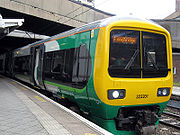 |
| Class 331 British Rail Class 332 The British Rail Class 332 is the type of electric multiple unit train used on the Heathrow Express between London Paddington and Heathrow Airport.-Description:The fleet was built in 1997-1998 by Siemens and CAF at the latter’s factory in Zaragoza, Spain... |
original classification of Class 332 | - | - | - | |
| Class 332 British Rail Class 332 The British Rail Class 332 is the type of electric multiple unit train used on the Heathrow Express between London Paddington and Heathrow Airport.-Description:The fleet was built in 1997-1998 by Siemens and CAF at the latter’s factory in Zaragoza, Spain... |
Heathrow Express Heathrow Express Heathrow Express is an airport rail link from London Heathrow Airport to London Paddington station in London operated by the Heathrow Express Operating Authority, a wholly owned subsidiary of BAA. It was opened by the then Prime Minister Tony Blair in 1998... |
Heathrow Express Heathrow Express Heathrow Express is an airport rail link from London Heathrow Airport to London Paddington station in London operated by the Heathrow Express Operating Authority, a wholly owned subsidiary of BAA. It was opened by the then Prime Minister Tony Blair in 1998... |
Siemens/CAF 1997-1998 2002[4→5Car] |
9 x 4-car sets 5 x 5-car sets |
 |
| Class 333 British Rail Class 333 The British Rail Class 333 electric multiple units were built by Siemens and CAF are based on the Class 332 trains operated by Heathrow Express.-Description:... |
Arriva Trains Northern Arriva Trains Northern Arriva Trains Northern was a train operating company that operated passenger trains in Yorkshire and the North East of England. The company had previously been known as Northern Spirit before being taken over by Arriva.... (for West Yorkshire PTE) |
Northern Rail Northern Rail Northern Rail is a British train operating company that has operated local passenger services in Northern England since 2004. Northern Rail's owner, Serco-Abellio, is a consortium formed of Abellio and Serco, an international operator of public transport systems... |
Siemens/CAF 2000 | 18 x 4-car sets |  |
| Class 334 British Rail Class 334 The British Rail Class 334 is a suburban electric multiple unit built by Alstom in Birmingham. They are part of the Juniper family of trains along with Classes 458 and 460. They were built for SPT/ScotRail outer suburban services in Glasgow, UK. They later became part of First ScotRail/SPT fleet... Juniper |
ScotRail ScotRail ScotRail was a brand name used for all Scottish regional and commuter rail services, including some cross-border services, from 1997 to 2004.... (for Strathclyde PTE) |
First ScotRail First ScotRail ScotRail Railways Ltd. is the FirstGroup-owned train operating company running domestic passenger trains within Scotland, northern England and the cross-border Caledonian Sleeper service to London using the brand ScotRail which is the property of the Scottish Government... |
Alstom Birmingham 1999-2002 | 40 x 3-car sets |  |
| Class 341 Networker |
proposed units for Crossrail Crossrail Crossrail is a project to build a major new railway link under central London. The name refers to the first of two routes which are the responsibility of Crossrail Ltd. It is based on an entirely new east-west tunnel with a central section from to Liverpool Street station... |
- | (never built) | - | |
| Class 342 Networker |
proposed units for CTRL Domestic Services | - | (never built) | - | |
| Class 345 British Rail Class 345 Class 345 is the registered rolling stock class name for the planned fleet to operate the London Crossrail routes across Central London when complete in 2018... |
Crossrail Crossrail Crossrail is a project to build a major new railway link under central London. The name refers to the first of two routes which are the responsibility of Crossrail Ltd. It is based on an entirely new east-west tunnel with a central section from to Liverpool Street station... |
Approx 60 x 5-car sets | |||
| Class 350 British Rail Class 350 The British Rail Class 350 "Desiro" is class of electrical multiple unit built by Siemens AG from 2004–05 and 2008–09. Thirty of these units, designated Class 350/1, were built for use by Central Trains and Silverlink on regional express services and services on the southern section of the West... Desiro |
Silverlink Silverlink Silverlink Train Services Ltd was a train operating company in the United Kingdom. It operated routes in North London and from London to Northampton... , Central Trains Central Trains Central Trains was one of the original 25 train operating companies to emerge from the break-up of British Rail between 1994 and 1997. The company operated local, urban and secondary express services across central England and Mid Wales.-Overview:... |
London Midland London Midland London Midland is a train operating company in the United Kingdom. Legally named London and Birmingham Railway Ltd, it is a subsidiary of Govia, and has operated the West Midlands franchise since 11 November 2007.... |
Siemens 2004-05 2008-09 |
67 x 4-car sets |  |
| Class 357 British Rail Class 357 The British Rail Class 357 "Electrostar" alternating current electric multiple units were built by ADtranz at their Litchurch Lane Works in Derby, England, in two batches from 1999 to 2002 at a cost of approximately £292 million... Electrostar |
LTS Rail | c2c C2c c2c is a British train operating company that is part of the National Express Group. It provides passenger rail services on the London, Tilbury and Southend Railway line from Fenchurch Street railway station in the City of London to east London and the entire length of the northern Thames Gateway... |
Adtranz/Bombardier Derby 1999-2001 2001-02 |
74 x 4-car sets |  |
| Class 360 British Rail Class 360 The British Rail Class 360 electric multiple units were built by Siemens in two sub-types from 2002-2003 and 2004-2005. These units are part of the Siemens Desiro family.The Siemens "Desiro UK" family also includes units of Classes 185, 350, 380, 444 and 450.... Desiro |
First Great Eastern First Great Eastern First Great Eastern was an award-winning train operating company that operated suburban, local and medium distance train services from London Liverpool Street via Romford to Essex and Ipswich in the United Kingdom on the Great Eastern Main Line railway.First Group gained the Great Eastern... , Heathrow Connect Heathrow Connect Heathrow Connect is a train operating company in London provided jointly by Heathrow Express and First Great Western, connecting Heathrow Airport with station. The service follows the same route as the Heathrow Express service but serves intermediate stations en route, thus connecting several... |
National Express East Anglia, Heathrow Connect Heathrow Connect Heathrow Connect is a train operating company in London provided jointly by Heathrow Express and First Great Western, connecting Heathrow Airport with station. The service follows the same route as the Heathrow Express service but serves intermediate stations en route, thus connecting several... |
Siemens 2002-03 2004-2005 |
21 x 4-car sets 5 x 5-car sets |
 |
| Class 365 British Rail Class 365 The British Rail Class 365 "Networker Express" are dual-voltage 25 kV AC and 750 V DC) electric multiple units built by ABB at York from 1994 to 1995. These were the last units to be built at the York factory before it closed... Networker |
Network SouthEast Network SouthEast Network SouthEast was one of three passenger sectors of British Rail created in 1982. NSE principally operated commuter trains in the London area and inter-urban services in densely populated South East England, although the network reached as far west as Exeter... (Great Northern and South Eastern services) |
First Capital Connect First Capital Connect First Capital Connect is a passenger train operating company in England that began operations on the National Rail network on 1 April 2006... |
ABB York 1994-95 | 41 x 4-car sets |  |
| Class 371 British Rail Classes 371, 381 and 471 Class 371, Class 381 and Class 471 were proposed electric multiple unit classes from the Networker family of trains intended to operate services in the south-east of England.-Class 371 and 381:... Networker |
proposed units for Thameslink 2000 | - | (never built) | - | |
| Class 375 British Rail Class 375 The British Rail Class 375 Electrostar electric multiple unit train was built by Bombardier Transportation at their Derby Works, from 1999 to 2005... Electrostar Electrostar Electrostar is the name given to a series of related electric multiple-unit passenger trains manufactured by Bombardier Transportation at their Litchurch Lane Works in Derby, England... |
Connex South Eastern Connex South Eastern Connex South Eastern was a train operating company in the United Kingdom. It was owned by the Connex Group and operated between 14 October 1996 and 9 November 2003. The company operated passenger services in South London and Kent... , South Eastern Trains South Eastern Trains South Eastern Trains was a British train operating company, in public ownership, that provided train services in south east London and South East England from 9 November 2003 to 31 March 2006.... |
Southeastern Southeastern (train operating company) London & South Eastern Railway Limited, trading as Southeastern is a train operating company in south-east England. On 1 April 2006 it became the franchisee for the new Integrated Kent Franchise , replacing the publicly owned South Eastern Trains on the former South East Franchise... |
Adtranz/Bombardier Derby 1999-2005 | 10 x 3-car sets 102 x 4-car sets |
 |
| Class 376 British Rail Class 376 The Class 376 Suburban Electrostar is a model of electric multiple-unit passenger train manufactured by Bombardier Transportation. It is part of the Electrostar family, which are the most common EMUs introduced since the privatisation of British Rail... Electrostar |
South Eastern Trains South Eastern Trains South Eastern Trains was a British train operating company, in public ownership, that provided train services in south east London and South East England from 9 November 2003 to 31 March 2006.... |
Southeastern Southeastern (train operating company) London & South Eastern Railway Limited, trading as Southeastern is a train operating company in south-east England. On 1 April 2006 it became the franchisee for the new Integrated Kent Franchise , replacing the publicly owned South Eastern Trains on the former South East Franchise... |
Bombardier Derby 2004-06 | 36 x 5-car sets |  |
| Class 377 British Rail Class 377 The Class 377 Electrostar is an electric multiple unit type built by Bombardier Transportation at their Derby Works, from 2001 to present. The Electrostar family, which also includes Classes 357, 375, 376, 378, and 379, is the most numerous type of EMU built in the post-privatisation period of... Electrostar |
Southern Southern (train operating company) Southern is a train operating company in the United Kingdom. Officially named Southern Railway Ltd., it is a subsidiary of Govia, a joint venture between transport groups Go-Ahead Group and Keolis, and has operated the South Central rail franchise since October 2000 and the Gatwick Express service... |
Southern Southern (train operating company) Southern is a train operating company in the United Kingdom. Officially named Southern Railway Ltd., it is a subsidiary of Govia, a joint venture between transport groups Go-Ahead Group and Keolis, and has operated the South Central rail franchise since October 2000 and the Gatwick Express service... , First Capital Connect First Capital Connect First Capital Connect is a passenger train operating company in England that began operations on the National Rail network on 1 April 2006... |
Bombardier Derby 2001-05 2008-2009 |
28 x 3-car sets 154 x 4-car sets |
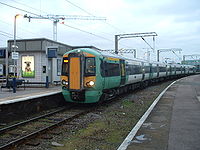 |
| Class 378 British Rail Class 378 The Class 378 Capitalstar is a type of electric multiple-unit train, part of Bombardier Transportation's Electrostar family. These trains are operating on the new London Overground network... Capitalstar |
London Overground London Overground London Overground is a suburban rail network in London and Hertfordshire. It has been operated by London Overground Rail Operations since 2007 as part of the National Rail network, under the franchise control and branding of Transport for London... |
London Overground London Overground London Overground is a suburban rail network in London and Hertfordshire. It has been operated by London Overground Rail Operations since 2007 as part of the National Rail network, under the franchise control and branding of Transport for London... |
Bombardier Derby 2009-2010 | 57 x 4-car sets | |
| Class 379 British Rail Class 379 The Class 379 Electrostar is a British electric multiple-unit train type ordered in April 2009 for Stansted Express services operated by National Express East Anglia . The trains will also be used on services between , and... Electrostar II |
National Express East Anglia | National Express East Anglia | Bombardier Derby 2011 | 30 x 4-car sets | |
| Class 380 British Rail Class 380 Class 380 is the designation given to a class of electric multiple unit trains which operate on the national railway network in Scotland.- Description :... Desiro |
First ScotRail First ScotRail ScotRail Railways Ltd. is the FirstGroup-owned train operating company running domestic passenger trains within Scotland, northern England and the cross-border Caledonian Sleeper service to London using the brand ScotRail which is the property of the Scottish Government... |
ScotRail | Siemens 2009-2011 | 22 x 3-car sets 16 x 4-car sets |
|
| Class 381 British Rail Classes 371, 381 and 471 Class 371, Class 381 and Class 471 were proposed electric multiple unit classes from the Networker family of trains intended to operate services in the south-east of England.-Class 371 and 381:... Networker |
proposed Network SouthEast Network SouthEast Network SouthEast was one of three passenger sectors of British Rail created in 1982. NSE principally operated commuter trains in the London area and inter-urban services in densely populated South East England, although the network reached as far west as Exeter... express units |
- | (never built) | - |
High speed trains

| TOPS class | Built for | Current Operator(s) | Builder | Number Built | Image |
|---|---|---|---|---|---|
| Class 370 British Rail Class 370 British Rail's Class 370 tilting trains, also referred to as APT-P , were the pre-production Advanced Passenger Train units... APT-P |
prototype Advanced Passenger Train Advanced Passenger Train The Advanced Passenger Train was an experimental tilting High Speed Train developed by British Rail during the 1970s and early 1980s.... |
(out of service) | BREL Derby 1979 | 6 x 7-car half sets 2 spare cars |
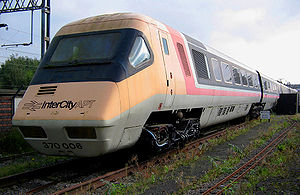 |
| Class 373 British Rail Class 373 The British Rail Class 373 or TGV-TMST train is an electric multiple unit that operates Eurostar's high-speed rail service between Britain, France and Belgium via the Channel Tunnel... TGV |
Eurostar Eurostar Eurostar is a high-speed railway service connecting London with Paris and Brussels. All its trains traverse the Channel Tunnel between England and France, owned and operated separately by Eurotunnel.... |
Eurostar Eurostar Eurostar is a high-speed railway service connecting London with Paris and Brussels. All its trains traverse the Channel Tunnel between England and France, owned and operated separately by Eurotunnel.... SNCF SNCF The SNCF , is France's national state-owned railway company. SNCF operates the country's national rail services, including the TGV, France's high-speed rail network... |
various builders 1992-96 | 14 x 8-car half sets 64 x 10-car half sets 1 spare car |
 |
| Class 390 British Rail Class 390 The Class 390 Pendolino is a type of train used in Great Britain. They are electric multiple units using Fiat's tilting train pendolino technology and built by Alstom. Fifty-three 9-car units were originally built for Virgin Trains from 2001 to 2004 for operation on the West Coast Main Line , with... Pendolino |
Virgin West Coast Virgin Trains Virgin Trains is a train operating company in the United Kingdom. It operates long-distance passenger services on the West Coast Main Line between London, the West Midlands, North West England, North Wales and Scotland... |
Virgin Trains Virgin Trains Virgin Trains is a train operating company in the United Kingdom. It operates long-distance passenger services on the West Coast Main Line between London, the West Midlands, North West England, North Wales and Scotland... |
Alstom Birmingham 2001-04 | 53 x 9-car sets | 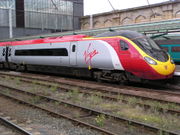 |
| Class 395 British Rail Class 395 British Rail Class 395 is a dual-voltage electric multiple unit used by train operating company Southeastern for its services along High Speed 1 and onwards to the Kent coast. The trains were built in Japan by Hitachi and shipped to the United Kingdom to operate new high speed domestic services... Javelin |
Southeastern Southeastern (train operating company) London & South Eastern Railway Limited, trading as Southeastern is a train operating company in south-east England. On 1 April 2006 it became the franchisee for the new Integrated Kent Franchise , replacing the publicly owned South Eastern Trains on the former South East Franchise... |
Southeastern Southeastern (train operating company) London & South Eastern Railway Limited, trading as Southeastern is a train operating company in south-east England. On 1 April 2006 it became the franchisee for the new Integrated Kent Franchise , replacing the publicly owned South Eastern Trains on the former South East Franchise... |
Hitachi 2007-09 | 29 x 6-car sets |  |
Southern Region units
The Southern RailwaySouthern Railway (Great Britain)
The Southern Railway was a British railway company established in the 1923 Grouping. It linked London with the Channel ports, South West England, South coast resorts and Kent...
and its successor, the Southern Region of British Rail, used three letter codes
SR multiple unit numbering and classification
The Southern Railway created classification and numbering systems for its large fleet of electric multiple units that were perpetuated by the Southern Region of British Rail until the early 1980s, when the impact of TOPS was felt...
to classify their DC EMU fleets, as shown after the TOPS
TOPS
Total Operations Processing System, or TOPS, is a computer system for managing the locomotives and rolling stock owned by a rail system...
class numbers. Southern Region EMUs were classified in the 400 series under TOPS.
Pre-Nationalisation

| TOPS class | SR class | Name or Information | Image |
|---|---|---|---|
| 2Nol SR Class 2Nol The Southern Railway gave the designation 2-NOL to the electric multiple units built during the 1930s from old London and South Western Railway carriage bodies on new underframes... |
|||
| 2SL SR Class 2SL The Southern Railway gave the designation 2-SL to the small fleet of electric multiple units dedicated for use on the South London lines. None of these units survived long enough in British Rail ownership to be allocated a TOPS class.-Construction:... |
South London | ||
| 2Wim SR Class 2Wim 2-WIM was the designation given, by Southern Railway , to a small fleet of electric multiple units, dedicated for use on the West Croydon to Wimbledon Line... |
Wimbledon-Croydon | ||
| 3Sub British Rail Class 405 Under the British Rail TOPS computer system, Class 415 was allocated to surviving examples of the Southern Railway 4-Sub Class electric multiple units built between 1941 and 1951... |
 |
||
| 4Buf British Rail Class 404 The Southern Railway gave the designations 4-COR, 4-RES, 4-BUF and 4-GRI to the different types of electric multiple unit built to work the route between London Waterloo and Portsmouth Harbour. The 4-COR type units survived long enough in British Rail ownership to be allocated TOPS Class 404... |
|||
| 4Gri British Rail Class 404 The Southern Railway gave the designations 4-COR, 4-RES, 4-BUF and 4-GRI to the different types of electric multiple unit built to work the route between London Waterloo and Portsmouth Harbour. The 4-COR type units survived long enough in British Rail ownership to be allocated TOPS Class 404... |
|||
| 4Lav SR Class 4Lav The Southern Railway gave the designation 4-LAV to the electric multiple units built to work the semi-fast services on the route between London and Brighton... |
 |
||
| 4Res British Rail Class 404 The Southern Railway gave the designations 4-COR, 4-RES, 4-BUF and 4-GRI to the different types of electric multiple unit built to work the route between London Waterloo and Portsmouth Harbour. The 4-COR type units survived long enough in British Rail ownership to be allocated TOPS Class 404... |
|||
| 6Cit SR Class 6Pul The Southern Railway gave the designations 6-PUL, 6-CITY and 6-PAN to electric multiple units built to work the routes between London and Brighton, West Worthing and Eastbourne. None of these units survived long enough in British Rail ownership to be allocated a TOPS class number... |
London Bridge-Brighton | ||
| 6Pan SR Class 6Pul The Southern Railway gave the designations 6-PUL, 6-CITY and 6-PAN to electric multiple units built to work the routes between London and Brighton, West Worthing and Eastbourne. None of these units survived long enough in British Rail ownership to be allocated a TOPS class number... |
Pantry units | ||
| 6Pul SR Class 6Pul The Southern Railway gave the designations 6-PUL, 6-CITY and 6-PAN to electric multiple units built to work the routes between London and Brighton, West Worthing and Eastbourne. None of these units survived long enough in British Rail ownership to be allocated a TOPS class number... |
Pullman Pullman (car or coach) In the United States, Pullman was used to refer to railroad sleeping cars which were built and operated on most U.S. railroads by the Pullman Company from 1867 to December 31, 1968.... London Victoria-Brighton |
||
| Class 401 British Rail Class 401 The Southern Railway gave the designation 2-BIL to the DC third rail electric multiple units built during the 1930s to work long-distance semi-fast services on the newly electrified lines from London to Eastbourne, Portsmouth and Reading... |
2Bil |  |
|
| Class 402 British Rail Class 402 The Southern Railway gave the designation 2-HAL to the electric multiple units built during the late 1930s to work long-distance semi-fast services on the newly electrified lines from London to Maidstone and Gillingham... |
2Hal 2Pan |
||
| Class 403 British Rail Class 403 The Southern Railway gave the designation 5BEL to the 5-car all-Pullman electric multiple units which worked the prestigious Brighton Belle trains between London Victoria and Brighton. These units survived long enough in British Rail ownership to be allocated TOPS Class 403... |
5Bel | ||
| Class 404 British Rail Class 404 The Southern Railway gave the designations 4-COR, 4-RES, 4-BUF and 4-GRI to the different types of electric multiple unit built to work the route between London Waterloo and Portsmouth Harbour. The 4-COR type units survived long enough in British Rail ownership to be allocated TOPS Class 404... |
4Cor | 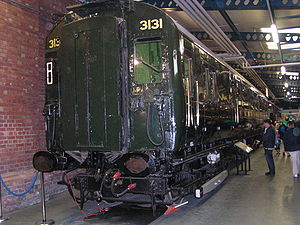 |
|
| Class 405 British Rail Class 405 Under the British Rail TOPS computer system, Class 415 was allocated to surviving examples of the Southern Railway 4-Sub Class electric multiple units built between 1941 and 1951... |
4Sub | 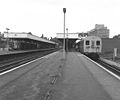 |
Mark 1 and 2 bodyshell


| TOPS class | SR class | Name or Information | Image |
|---|---|---|---|
| 4DD SR Class 4DD Conceived by Oliver Bulleid for the Southern Railway's Dartford commuter route, the two 4DD electric multiple units were the only double-deck trains to run on the main line railway network in Britain. Whilst common in Europe and North America the restrictive railway loading gauge in the United... |
Double Deck EMU |  |
|
| Class 410 | 4Bep | ||
| Class 411 British Rail Class 411 The British Rail Class 411 electrical multiple units were built at Eastleigh works from 1956-63 for the newly electrified main lines in Kent. These units were based on the earlier Southern Railway 4Cor design, built in 1937. They were replaced by Juniper units.-Description:A total of 133 units... |
4Cep | ||
| Class 412 | 4Bep | ||
| Class 413 British Rail Class 413 The British Rail Class 413 units were formed in 1982 by permanently coupling two Class 414 2Hap units together. The cabs in the centre of the unit were decommissioned, thus reducing the weight of the units.... |
4Cap | 2 x 2Hap permanently coupled | |
| Class 414 British Rail Class 414 The British Rail Class 414 electric multiple units were built between 1956 and 1963.209 of these two car units were built to two similar sub-classes. The first batch of thirty-six units were built on the underframes of older SR Class 2Nol units, and numbered in the range 5601-5636... |
2Hap | 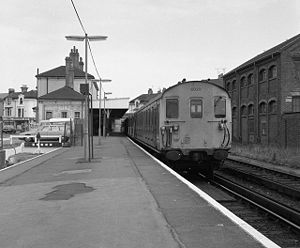 |
|
| Class 415 British Rail Class 415 British Rail Class 415 was a suburban 750 V DC third rail electric multiple unit commissioned by the Southern Region of British Railways. Built between 1951 and 1957, it became the most numerous class on the region after the withdrawal of the 4Subs... |
4EPB | 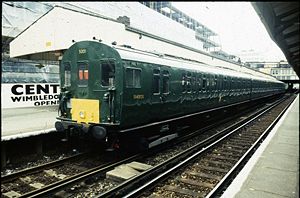 |
|
| Class 416 British Rail Class 416 British Rail Class 416 electric multiple units were built between 1953 and 1956. They were intended for inner suburban passenger services on London's Southern Electric network... |
2EPB | 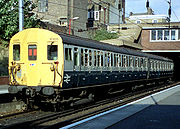 |
|
| Class 418 British Rail Class 418 British Rail Class 418 was a class of electrical multiple unit commissioned by British Railways Southern Region. in England. The units were formed in the 1970s by simply declassifying the first class accommodation in selected 2Hap units. They were employed on inner suburban routes such as the... |
2Sap | 2Hap units with declassified 1st Class accommodation | 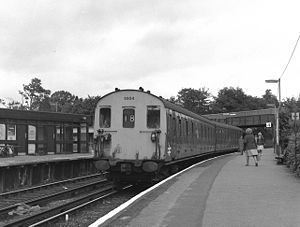 |
| Class 419 British Rail Class 419 The British Rail Class 419 Motor Luggage Vans were built from 1951-61 by BR at Eastleigh Works.-Description:Ten of these units were built for the boat trains from London Victoria to Dover and Folkestone... |
MLV | London-Dover/Folkestone boat trains |  |
| Class 420 | 4Big | 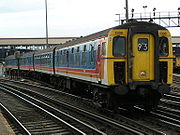 |
|
| Class 421 British Rail Class 421 The British Rail Class 421 electrical multiple units were built at BR York Works between 1964 and 1972. Units were built in two batches, and were initially introduced on services on the Brighton Main Line. Later units were introduced on services to Portsmouth. These units replaced older Southern... |
4/3Cig 3Cop |
Last 2 units of this type in service were withdrawn in 2010 | |
| Class 422 | 4Big 8Dig |
||
| Class 423 British Rail Class 423 The British Rail Class 423 electrical multiple units were built by BR at York Works from 1967 to 1974, although the MBSOs and TSOs of the first 20, 7701-7720, were constructed at Derby Works. They feature manually-opening doors next to every seating row and were the last coaching stock built in... |
4Vep 4Vop |
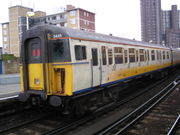 |
|
| Class 427 | 4Veg | First stock used for Gatwick Express | |
| Class 430 British Rail Class 432 The British Rail 4-REP electric multiple units were built by BR at York Works from 1966-1967 and 1974. The units were built to power the 4-TC trailer units on services on the South Western Main Line. Fifteen four-car units were eventually built. The motor coaches were new build, but the trailers... |
4Rep | ||
| Class 431 British Rail Class 432 The British Rail 4-REP electric multiple units were built by BR at York Works from 1966-1967 and 1974. The units were built to power the 4-TC trailer units on services on the South Western Main Line. Fifteen four-car units were eventually built. The motor coaches were new build, but the trailers... |
6Rep | ||
| Class 432 British Rail Class 432 The British Rail 4-REP electric multiple units were built by BR at York Works from 1966-1967 and 1974. The units were built to power the 4-TC trailer units on services on the South Western Main Line. Fifteen four-car units were eventually built. The motor coaches were new build, but the trailers... |
4Rep | ||
| Class 438 British Rail Class 438 The British Rail TC multiple units were un-powered fixed formations of 3 or 4 carriages with a driving position at each end of the set, converted by BR at York Works from locomotive-hauled Mark 1 carriages in 1966-1967 and 1974. The units built on experience gained from the prototype 6TC unit... |
3TC 4TC |
 |
|
| Class 480 | 8Vab | ||
| Class 482 (I) British Rail Class 421 The British Rail Class 421 electrical multiple units were built at BR York Works between 1964 and 1972. Units were built in two batches, and were initially introduced on services on the Brighton Main Line. Later units were introduced on services to Portsmouth. These units replaced older Southern... |
8Mig | ||
| Class 488 British Rail Class 488 The British Rail Class 488 are unpowered trailer sets, converted from Mark 2F coaches for the Gatwick Express service from London Victoria railway station to Gatwick Airport.... |
Gatwick Express Trailers |  |
|
| Class 489 British Rail Class 489 The British Rail Class 489 is a type of electrical multiple unit, specially converted for use on Gatwick Express trains, from London Victoria to Gatwick Airport.... |
GLV | Gatwick Express driving trailers |  |
| Class 499 (I) British Rail Class 499 British Rail allocated Class 499 to a fleet of six luggage vans used in electric multiple unit formations on boat train services between London and Dover. They were allocated Southern Region class TLV .... |
TLV |
TubeLondon UndergroundThe London Underground is a rapid transit system serving a large part of Greater London and some parts of Buckinghamshire, Hertfordshire and Essex in England...
Stock

| TOPS class | SR class | Name or Information | Image |
|---|---|---|---|
| Class 482 (II) British Rail Class 482 This article concerns the trains used on the Waterloo & City Line immediately prior to its takeover by London Underground in 1994. For their service after 1994, see London Underground 1992 Stock... |
Waterloo & City Line sold to LU London Underground The London Underground is a rapid transit system serving a large part of Greater London and some parts of Buckinghamshire, Hertfordshire and Essex in England... |
 |
|
| Class 483 British Rail Class 483 The British Rail Class 483 electrical multiple units were originally built as 1938 tube stock units for London Underground. They were extensively refurbished between 1989 and 1992 by Eastleigh Works, for use on services on the Isle of Wight's Island Line. This was despite having already worked for... |
Isle of Wight ex LU 1938 stock |
 |
|
| Class 485 British Rail Class 485 The British Rail Class 485 and British Rail Class 486 electrical multiple units were original built for the London Electric Railway from 1923-31 as their 'Standard' tube stock... |
4Vec | ex LU Standard stock | 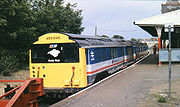 |
| Class 486 | 3Tis | ex LU Standard stock | 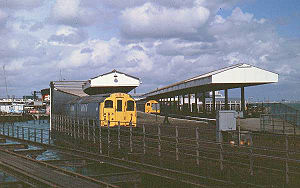 |
| Class 487 British Rail Class 487 The British Rail Class 487 electric multiple units were built by English Electric in 1940, for use on the Waterloo & City Line.Twelve motor carriages , numbered 51–62, and sixteen trailers , numbered 71–86, were built... |
Waterloo & City Line |  |
Modern EMUs


| TOPS class | SR class | Name or Information | Image |
|---|---|---|---|
| Class 424 British Rail Class 424 The British Rail Class 424 "Networker Classic" electric multiple unit was built in 1997 by ADtranz at Derby. It was a prototype vehicle rebuilt from a Class 421 driving trailer vehicle.... |
Networker Classic Prototype | ||
| Class 442 British Rail Class 442 The British Rail Class 442 Wessex Electric electrical multiple units were introduced in 1988 on the South Western Main Line from London Waterloo to Southampton Central, Bournemouth, Poole and Weymouth. Twenty-four of these 5-car units were built in 1988/89 by BREL at its Derby works... |
5Wes | Wessex Express |  |
| Class 444 British Rail Class 444 The British Rail Class 444 Desiro electrical multiple units were built in Germany by Siemens AG from 2003-04. Forty-five of these units were built for express services for South West Trains.... |
5Des | Desiro Desiro The Siemens Desiro is a family of diesel or electric multiple unit passenger trains. The main variants are the Desiro Classic, Desiro ML, Desiro UK and the future Desiro City and Desiro RUS. The trains are mostly used for commuter and regional services, and their rapid acceleration makes them... |
 |
| Class 445 | 4Pep | Second Generation EMU prototype - 4 car | 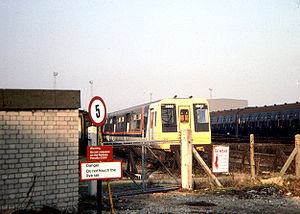 |
| Class 446 | 2Pep | Second Generation EMU prototype - 2 car | |
| Class 447 British Rail Class 447 Class 447 was the designation given to the Electric multiple unit trains that would have run the shuttle services between London Victoria and the entertainment complex planned for the site of the former Battersea Power Station... |
Proposed Battersea Bullet | ||
| Class 450 British Rail Class 450 The British Rail Class 450 third-rail DC EMU began service during 2003. They are a part of the Siemens Desiro modular train family and are more commonly known as the 'Blue Desiro'... |
4Des | Desiro Desiro The Siemens Desiro is a family of diesel or electric multiple unit passenger trains. The main variants are the Desiro Classic, Desiro ML, Desiro UK and the future Desiro City and Desiro RUS. The trains are mostly used for commuter and regional services, and their rapid acceleration makes them... |
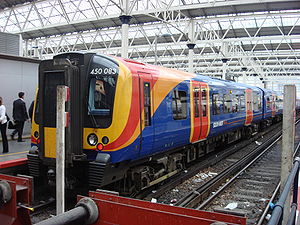 |
| Class 455 British Rail Class 455 The British Rail Class 455 is a type of electric multiple unit drawing power from a 750 V DC third rail. Built by BREL at York works in the early and mid-1980s, they were initially categorised as Class 510 as the successor to the Class 508... |
 |
||
| Class 456 British Rail Class 456 The British Rail Class 456 electric multiple-unit trains were built by BREL at York Works from 1990-91.- Description :24 two-car units were built as direct replacements for the elderly Class 416 2EPB units which operated on the Central Division of the Southern Region of British Rail. Units were... |
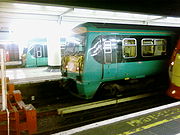 |
||
| Class 457 British Rail Class 457 Class 316 and Class 457 were TOPS classifications assigned to a single electric multiple unit at different stages of its use as a prototype for the Networker series.-Project:... |
DC Networker prototype |  |
|
| Class 458 British Rail Class 458 The South West Trains Class 458 electrical multiple units were built by Alstom at Washwood Heath between 1998 and 2002. These units are part of Alstom's Juniper family of units, which also includes Classes 334 and 460.-Description:... |
4Jop | Juniper Juniper (train) The Coradia Juniper series is a family of electric multiple unit trains built by Alstom Transport Birmingham, subcontractor: Ganz Hunslet, Hungary for use on the railway network in Great Britain. The family is related to the Coradia 1000 series of diesel multiple unit... |
 |
| Class 460 British Rail Class 460 The British Rail Class 460 electrical multiple units were built by Alstom at Washwood Heath from 2000-01. These units are part of Alstom's "Juniper" family of units, which also includes Classes 334 and 458... |
8Gat | Juniper - Gatwick Express Gatwick Express Gatwick Express is the name given to the frequent rail shuttle service between Victoria station in London and Gatwick Airport in South East England, operated by the Southern franchise... |
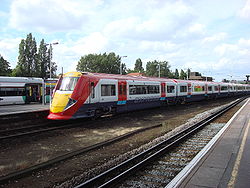 |
| Class 465 British Rail Class 465 The British Rail Class 465 Networker electric multiple units were built by GEC Alsthom and BREL between 1991 and 1993, and by ABB Rail between 1993 and 1994. They were brought into service from 1991 onwards. They are mostly used on suburban routes serving the South East of England, now operated by... |
Networker - 4 car |  |
|
| Class 466 British Rail Class 466 The Class 466 750 V DC third rail electric multiple unit is a suburban EMU, which operates with Class 465 EMUs in southeast London and Kent on the Southeastern network... |
Networker - 2 car | 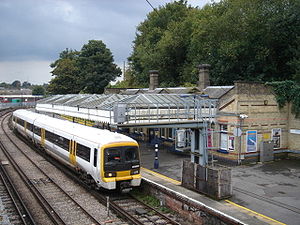 |
|
| Class 471 | Proposed Networker - Main Line Express |
Other DC units
The 500 series classes were reserved for miscellaneous DC EMUs not from the Southern Region. This included the DC (third/fourth rail) lines in North LondonLondon
London is the capital city of :England and the :United Kingdom, the largest metropolitan area in the United Kingdom, and the largest urban zone in the European Union by most measures. Located on the River Thames, London has been a major settlement for two millennia, its history going back to its...
, Manchester
Manchester
Manchester is a city and metropolitan borough in Greater Manchester, England. According to the Office for National Statistics, the 2010 mid-year population estimate for Manchester was 498,800. Manchester lies within one of the UK's largest metropolitan areas, the metropolitan county of Greater...
and Merseyside
Merseyside
Merseyside is a metropolitan county in North West England, with a population of 1,365,900. It encompasses the metropolitan area centred on both banks of the lower reaches of the Mersey Estuary, and comprises five metropolitan boroughs: Knowsley, St Helens, Sefton, Wirral, and the city of Liverpool...
and the OHLE lines in Greater Manchester
Greater Manchester
Greater Manchester is a metropolitan county in North West England, with a population of 2.6 million. It encompasses one of the largest metropolitan areas in the United Kingdom and comprises ten metropolitan boroughs: Bolton, Bury, Oldham, Rochdale, Stockport, Tameside, Trafford, Wigan, and the...
. The DC electric network around Tyneside
Tyneside
Tyneside is a conurbation in North East England, defined by the Office of National Statistics, which is home to over 80% of the population of Tyne and Wear. It includes the city of Newcastle upon Tyne and the Metropolitan Boroughs of Gateshead, North Tyneside and South Tyneside — all settlements on...
had been de-electrified by the time TOPS
TOPS
Total Operations Processing System, or TOPS, is a computer system for managing the locomotives and rolling stock owned by a rail system...
was introduced, and the stock withdrawn or transferred to the Southern Region.

| Class | Info | Image | Notes |
|---|---|---|---|
| Class 501 British Rail Class 501 The British Rail Class 501 electric multiple units were built in 1957/58 for use on the former LNWR/LMS suburban electric network of the London Midland Region... |
North London London London is the capital city of :England and the :United Kingdom, the largest metropolitan area in the United Kingdom, and the largest urban zone in the European Union by most measures. Located on the River Thames, London has been a major settlement for two millennia, its history going back to its... stock |
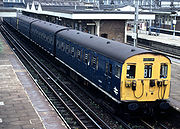 |
650 V Third & Fourth Rail |
| Class 502 British Rail Class 502 The British Rail Class 502 was a type of electric multiple unit originally built by the London Midland and Scottish Railway at their Derby Works... |
Liverpool Liverpool Liverpool is a city and metropolitan borough of Merseyside, England, along the eastern side of the Mersey Estuary. It was founded as a borough in 1207 and was granted city status in 1880... -Southport Southport Southport is a seaside town in the Metropolitan Borough of Sefton in Merseyside, England. During the 2001 census Southport was recorded as having a population of 90,336, making it the eleventh most populous settlement in North West England... /Ormskirk Ormskirk Ormskirk is a market town in West Lancashire, England. It is situated north of Liverpool city centre, northwest of St Helens, southeast of Southport and southwest of Preston.-Geography and administration:... stock |
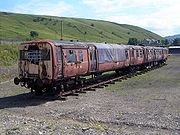 |
650 V Third Rail |
| Class 503 British Rail Class 503 British Rail Class 503 trains were 70 mph electric multiple units. They were introduced in two batches — in 1938 by the London, Midland and Scottish Railway with a further batch in 1956 by the then nationalised British Railways... |
Mersey Merseyside Merseyside is a metropolitan county in North West England, with a population of 1,365,900. It encompasses the metropolitan area centred on both banks of the lower reaches of the Mersey Estuary, and comprises five metropolitan boroughs: Knowsley, St Helens, Sefton, Wirral, and the city of Liverpool... -Wirral Metropolitan Borough of Wirral The Metropolitan Borough of Wirral is a metropolitan borough of Merseyside, in North West England. It has a population of 311,200, and encompasses of the northern part of the Wirral Peninsula. Major settlements include Birkenhead, Wallasey, Bebington, Heswall, Hoylake and West Kirby. The city of... stock |
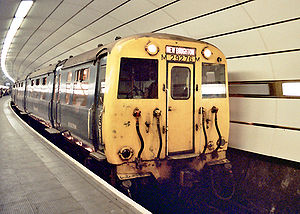 |
650 V Third Rail |
| Class 504 British Rail Class 504 The British Rail Class 504 was a unique type of electric multiple unit that ran on 1200 V DC third rail with side-contact current collection. All other UK third rail has the electric "shoe" on top of the rail. The type was used only between Manchester and Bury... |
Manchester Manchester Manchester is a city and metropolitan borough in Greater Manchester, England. According to the Office for National Statistics, the 2010 mid-year population estimate for Manchester was 498,800. Manchester lies within one of the UK's largest metropolitan areas, the metropolitan county of Greater... -Bury Bury Bury is a town in Greater Manchester, England. It lies on the River Irwell, east of Bolton, west-southwest of Rochdale, and north-northwest of the city of Manchester... stock |
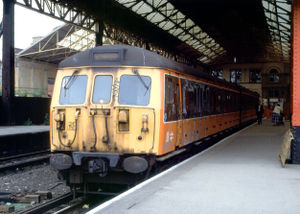 |
1.2 kV Side Contact Third Rail (Unique on BR network) |
| Class 505 British Rail Class 505 British Railways Class 505 were 1,500 V DC electric multiple units introduced in 1931 by the Manchester, South Junction and Altrincham Railway... |
Manchester-Altrincham Altrincham Altrincham is a market town within the Metropolitan Borough of Trafford, in Greater Manchester, England. It lies on flat ground south of the River Mersey about southwest of Manchester city centre, south-southwest of Sale and east of Warrington... stock |
1.5 kV OHLE | |
| Class 506 British Rail Class 506 The British Rail Class 506 was a 3 carriage Electric Multiple Unit built for local services between Manchester, Glossop and Hadfield on the Woodhead Line, which was electrified in 1954 on the 1,500V dc overhead system.-Design:... |
Manchester-Hadfield Hadfield, Derbyshire Hadfield is a parish and small residential town in High Peak, Derbyshire, England. It lies very close to the River Etherow which forms the border between Derbyshire and Greater Manchester... /Glossop Glossop Glossop is a market town within the Borough of High Peak in Derbyshire, England. It lies on the Glossop Brook, a tributary of the River Etherow, about east of the city of Manchester, west of the city of Sheffield. Glossop is situated near Derbyshire's county borders with Cheshire, Greater... stock |
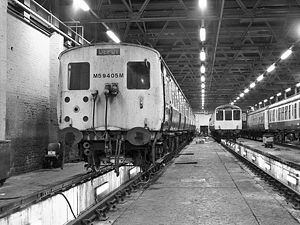 |
1.5 kV OHLE |
| Class 507 British Rail Class 507 British Rail Class 507 electric multiple units were built by BREL at York works in two batches from 1978 to 1980. The first thirty sets were constructed from September 1978 to mid-1979 and a further three were added during 1980... |
Merseyside stock | 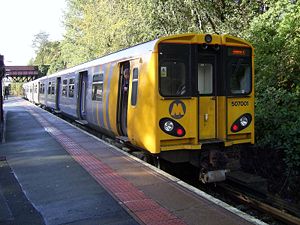 |
750 V Third Rail |
| Class 508 British Rail Class 508 The British Rail Class 508 electric multiple units were built by BREL at York works in 1979-80. They were the fourth variety of BR's then-standard 1972 design for suburban EMUs, eventually encompassing 755 vehicles and five classes... |
Merseyside stock |  |
750 V Third Rail |
| Class 510 British Rail Class 455 The British Rail Class 455 is a type of electric multiple unit drawing power from a 750 V DC third rail. Built by BREL at York works in the early and mid-1980s, they were initially categorised as Class 510 as the successor to the Class 508... |
Original classification of Class 455 |
Pre-TOPS classes
- Ex-LNER UnitsLNER electric unitsIn 1937 the London and North Eastern Railway ordered a fleet of articulated electric multiple unit passenger trains for use on the Tyneside Electric lines, which linked the English city of Newcastle upon Tyne with the coast at North Shields and South Shields...
(Tyneside stock) - Ex-LNWR UnitsLNWR electric unitsDuring 1909-1922 the London and North Western Railway embarked on a project to electrify their London inner-suburban network, encompassing the lines from London Euston to Watford and the North London Railway from London Broad Street to Richmond, including branch lines such as Watford to Croxley...
(North London stock) - Ex-LYR UnitsLYR electric unitsThe Lancashire and Yorkshire Railway electrified urban railway lines in Liverpool and Manchester in order to improve the service offered against the competition being put up by new electric tramways.-Liverpool electrification:...
(Manchester-Bury stock)
Battery electric multiple unit (BEMU)
This was a one-off unit, withdrawn before the introduction of TOPSTOPS
Total Operations Processing System, or TOPS, is a computer system for managing the locomotives and rolling stock owned by a rail system...
.
- 79998/79999British Rail BEMUThe Battery Electric Multiple Unit was an experimental two-car multiple unit, built at the same time and in the same style as the prototype Derby Lightweight Diesel multiple units....
Non National Rail units
All rail vehicles operating on part of the National Rail network are required to be given TOPS codes. For this reason, both London UndergroundLondon Underground
The London Underground is a rapid transit system serving a large part of Greater London and some parts of Buckinghamshire, Hertfordshire and Essex in England...
and Tyne & Wear Metro
Tyne and Wear Metro
The Tyne and Wear Metro, also known as the Metro, is a light rail system in North East England, serving Newcastle upon Tyne, Gateshead, South Tyneside, North Tyneside and Sunderland. It opened in 1980 and in 2007–2008 provided 40 million public journeys on its network of nearly...
trains have their own TOPS classes:
| Class | Info | Image | Notes |
|---|---|---|---|
| Class 499 (II) London Underground rolling stock The history of the London Underground's rolling stock is as complex as the history of the network itself. A wide variety of types have been operated, from the early days of steam locomotives and carriages through to today's electric multiple units... |
London Underground rolling stock | Classification given to all LU stock operating on NR, regardless of line | |
| Class 994 Tyne and Wear Metro rolling stock The Tyne and Wear Metro Rolling Stock or British Rail Class 994 serves the Tyne and Wear Metro, a metro system in North East England, serving Newcastle upon Tyne, Gateshead, South Tyneside, North Tyneside and Sunderland. Since the inception of the Metro the rolling stock has remained the same. The... |
Tyne & Wear Metro rolling stock |
See also
- British Rail locomotive and multiple unit numbering and classificationBritish Rail locomotive and multiple unit numbering and classificationA number of different numbering and classification schemes were used for locomotives and multiple units operated by British Railways , and this page explains the principal systems...
- SR multiple unit numbering and classificationSR multiple unit numbering and classificationThe Southern Railway created classification and numbering systems for its large fleet of electric multiple units that were perpetuated by the Southern Region of British Rail until the early 1980s, when the impact of TOPS was felt...
- British Rail coach designationsBritish Rail coach designationsThe London, Midland and Scottish Railway and the London and North Eastern Railway both developed a system of identifying railway carriages by means of alphabetic codes...

